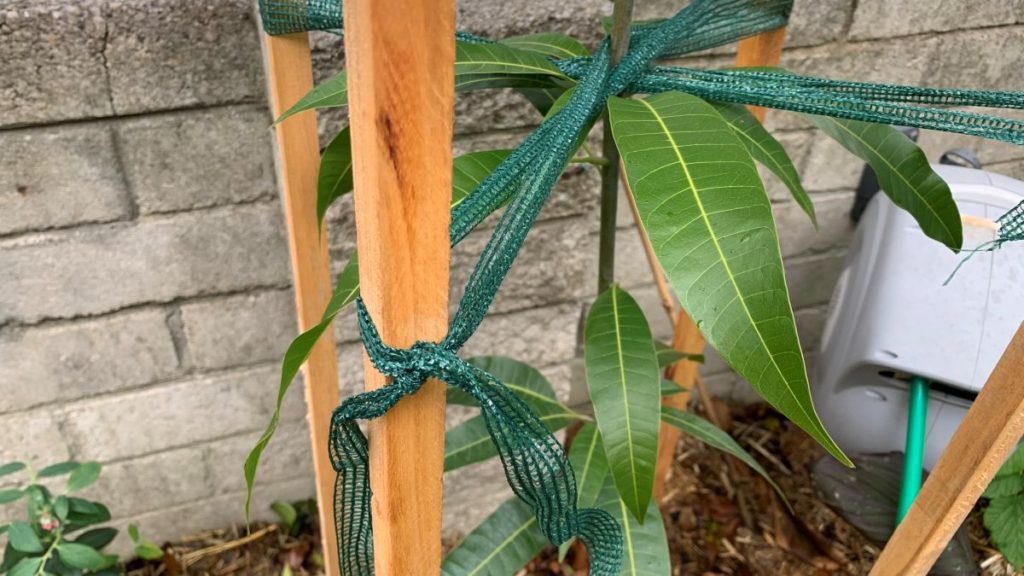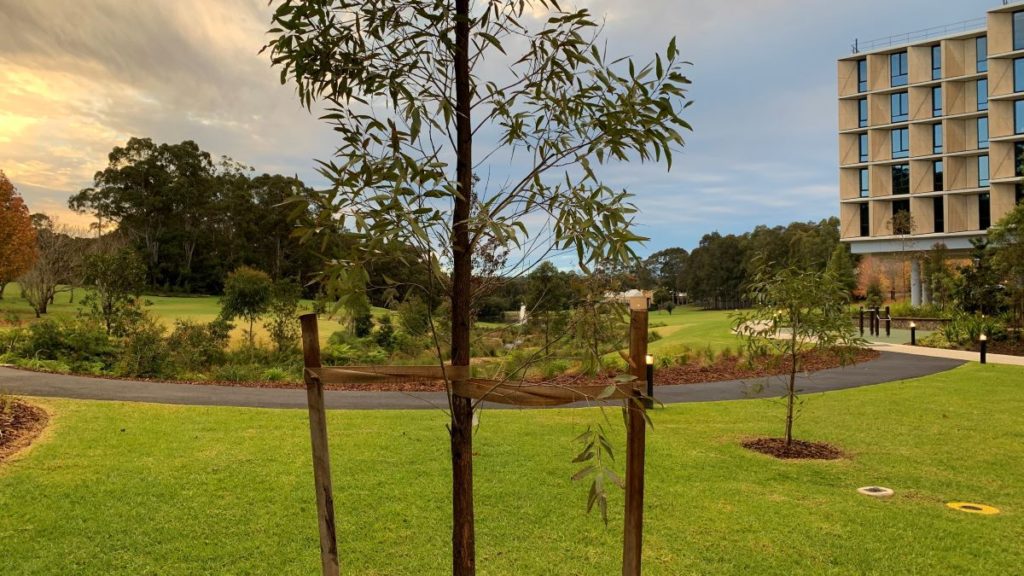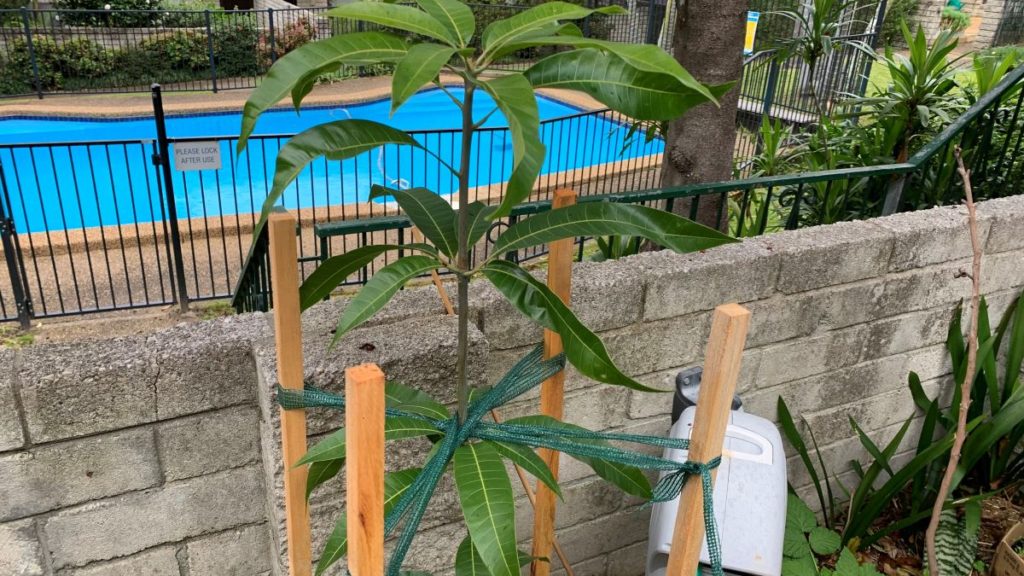Choose strong stakes for mango trees like hardwood and place them at least 1-2 feet from the root base. Place the stakes in a square around the base of the plant and tie the stem diagonally using plant ties. Tie the mango stem loosely so that stem can move and avoid any rub marks on the stem. Remove stakes after 1-2 years once the tree has grown a strong root system.
Young mango trees benefit from staking because their thin stems can easily snap in strong winds. Lots of movement in the stem can also damage small roots that are growing in the top soil. Here is my step by step guide to safely staking a young mango tree.
How to stake a mango tree – Key points
- Choose sustainably sourced hardwood stakes
- Use a natural ties or synthetic ties made from recycled plastic
- Check the mango stem regularly to make sure the ties are not rubbing
- Tie the mango loosely to allow for some movement to trigger good root growth
- Remove stakes after 1-2 years when the mango can stand on its own

What you will need to stake a mango tree
- 4x 5 foot long sustainably sourced hardwood or bamboo stakes
- Wide staking twine or hessian pieces cut 2 inches wide.
- Mallet or hammer
How to stake a mango tree- Step-by-Step
- Choose an area and plant your mango tree in soil that is rich with organic matter.
- Choose 4 strong stakes made from sustainably sourced hardwood.
- Using the mallet, knock the stakes in the ground around 1-2 feet from the base of the mango tree in the ground at least 10 inches.
- Using a piece of staking twine or hessian, wrap it around the first stake, twist it 1-2 times then place it around the mango stem. Twist 2 more times and tie around the stake diagonally opposite.
- Repeat this process across the other diagonal stakes.
- Trim off any excess twine.

Choosing mango stakes
Choose sustainably sourced, hardwood stakes that are at least 5 feet long. This natural timber will last well in your garden for at least 2 years which will be enough time to support your mango tree as it establishes.
You can also use thick bamboo stakes but these will need to be checked regularly and could need replacing after 1 year. These are an eco-friendly option as bamboo is a quick growing plant that can be grown without chemicals, grows quickly and traps carbon.

I have chosen a sustainably sourced hardwood for my mango tree that came in a pack of 6. I will use the other hardwood stakes to hold my tomatoes in the next growing season.

Choosing twine for staked mangoes
Use a natural fiber twine or synthetic twine made from recycled plastic. Synthetic twine will last longer and can be re-used over and over.
Natural fiber twines like hessian or jute fiber are an environmentally friendly way to keep your mango tree tied to the stakes. Hessian is a natural product so will break down over time and will need to be replaced after around 12 months. Natural fiber ties can be placed straight into your compost to break down.

Synthetic fiber ties will be longer lasting and can be used over again many times. I would re-use twine to tie tomatoes, peppers and aubergene. These last for long time in the weather and store easily in a garden shed.
I could not find any natural fiber twines in my local hardware store so this year I have gone for a synthetic tie. I will use this same piece of twine over and over on other plants in my garden and then eventually it can make it to soft plastic recycling.

How to stake your mango for the best growth
The key to successfully staking your mango tree is to tie the twine tight enough so that it stabilizes the tree in strong wind but still allows some movement. Making sure the twine is not wrapped too tightly will stop any stem damage and allow small stem movements.
When the mango tree is allowed to make small movements, the root system will adjust and strengthen growing larger and deeper to stabilize the tree. If the tree is tied up too tightly it can cause stem damage but also make the tree dependent on the ties for stability.
In the long run, we want our mango trees to stand on their own and not need stakes.
When to remove stakes from mango trees
Remove stakes and ties from mango trees 1-2 years after your tree has been planted in the ground. By this time your young mango tree should have grown deeper roots and roots that stabilize it sideways. Remove the ties gradually to make sure your mango is stable.
Remove one diagonal tie and after around 1 week you can remove the other tie. Leave the stakes in the ground in case you want to add a tie back on for a very windy day.
The idea is to gradually allow your mango tree to stand on its own and grow up to be a large, self-supported tree.
Managing your staked mango tree
Regularly check your mango ties and stem
It is important that you check your mango tree regularly to make sure that there are no wear marks on the stem from the ties. You may need to loosen the ties over time as the mango tree moves. Swap to a natural hessian or cotton ties made from old t-shirts for a softer tie.
Check mango stakes
After 2-3 weeks check the stability of the mango stakes. If the soil is soft, if you may need to hit the stakes into the ground deeper to keep them stable. If you see gaps around the bottom of the stake at the soil level it is likely that they are moving in the wind and need to be hit in deeper.
Check mango tree growth
Young mango trees grown from seedling can grow quickly so check the stem regularly to make sure that it hasn’t grown too thick and is being rubbed by the twine. Loosen the ties or remove them all together if the tree feels stable in the ground.
The best method is to remove one diagonal tie first when you know the weather will be calm and there is no wind. After 1-2 weeks you can remove the other tie and allow your mango to grow on its own.
I like to leave the stakes in near the tree in case I want to re-tie the tree on a windy day or feel like it need to be tied for longer.

Staking a mango tree – Summary
Young mango trees will need a stake to keep them from breaking in strong winds. Remember to remove stakes after they have established and developed a strong root system in the soil. Water and feed them regularly with organic fertilizer like pelleted chicken manure, aged cow manure and compost.
A healthy tree will grow a healthy root system and will eventually grow well on its own without a stake.
Mango Tree Articles
- Mango trees growing slow | How to help them grow 2X faster
- How to stake a mango tree | Step-By-Step Guide
- Grafted mango tree vs seedling mango tree | Which is better?
- Are mango trees evergreen? | Do they lose their leaves in Winter?
- Are mango trees self pollinating? | Do I need more than 1 mango tree?
- Growing mango trees in containers | Simple steps to success
- Where to plant a mango tree | Easy guide for your yard
- How often to water a mango tree | Spring, summer + winter guide
I am an accredited practicing dietitian, experienced gardener and a dedicated cook. I love writing and sharing my experience so you can learn from my successes and mistakes.

Comments are closed.